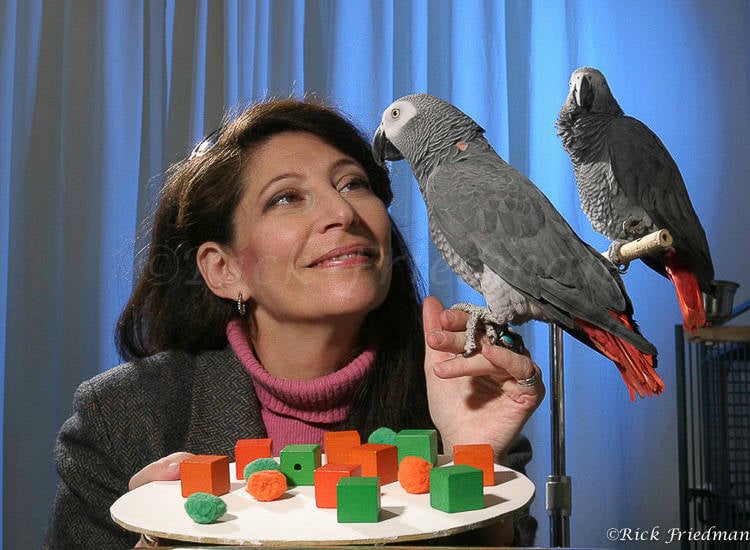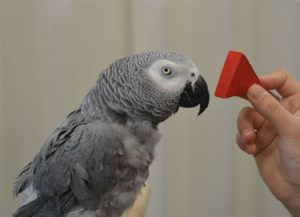Contents
3.0 Who are they?
Widely regarded as one of the smartest species of birds around (Holman, 2008), grey parrots are well known for their imitation abilities, as well as their capacity for logic and certain abstract concepts.
With English as a medium and a surprising ability to answer questions, some grey parrots in particular can make it seem like they have the capacity for language.
3.1 The African Grey Parrot
Psittacus erithacus, more commonly known as the African grey parrot, is a species of the Psittacidae family that originates from the savannas, coastal mangroves, woodland and edges of forest clearings of Central and West Africa. There are two subspecies of African grey parrots, namely the Timneh African grey and the Congo African grey, of which the latter is more popular amongst pet owners (“African Grey Parrot Personality, Food & Care – Pet Birds by Lafeber Co.”, n.d.).
3.2 Vocalization and communication in the wild
In the wild, grey parrots communicate via a variety of different types of calls and vocalizations, including alarm calls, contact calls, food begging calls, and agonistic calls (Holman, 2008). They are also known to follow a daily pattern of vocalizations, where there are two main periods of vocalization in a day. The flock is generally quiet from sunset till dawn, until they vocalize at day break prior to dispersing to forage at various locations. Upon returning to the roosting site at dusk, there is another period of vocalization, and the cycle repeats the next day. The young learn these vocalizations from parents and flock mates, allowing for cultural transmission of vocalizations from generation to generation of grey parrots (Holman, 2008). Furthermore, to summarize a finding by Bottoni et al. (2003), African grey parrots are able to distinguish the similarities and differences in musical note frequencies and even master the musical code. This demonstrates their complex cognitive competence.
3.3 Vocalization and communication in human captivity
In human captivity, the physical capacities of African grey parrots ―namely speech perception and production― include being able to distinguish and reproduce most human tokens (vowels, consonants) accurately, as well as human-like formant structures (Gibson & Tallerman, 2012). Formants are concentrations of acoustic energy around a particular frequency in the speech wave, such that each different formant corresponds to a resonance in the vocal tract. These formants can be clearly observed as dark bands in wideband spectrograms, giving an estimate of vocal tract resonances in the case of voice (Wood, 2005). This thus means that grey parrots can replicate the resonances of human voice accurately. They are also able to repeat words and phrases after hearing them just once or twice. Unlike the habits of those in the wild as mentioned above, pet parrots will not learn appropriate vocalizations, but will show similar patterns and use of calls (Holman, 2008).
African grey parrots are also capable of imitation and referential communication, of which they are most widely known for imitation of human speech. This bird reaches full talking ability around a year of age, and most individuals become capable mimics much earlier (“African Grey Parrot Personality, Food & Care – Pet Birds by Lafeber Co.”, n.d.). They use reproduced English speech sounds to meaningfully interact with humans and to comment on items of interest in their lives (Gibson & Tallerman, 2012), and are able to learn novel vocalizations by isolating a sound from background noise, imitating it, categorizing the acoustic stimulus, encoding it into long term memory, and monitoring the output sound to match it with the internal template (Bottoni, et al., 2003). Grey parrots in captivity have also been observed to carry out untrained vocal practice and sound play (Pepperberg, 2010). In addition, it has been found that they learn socially, by observing moods in situations and emulating the noises used in such cases when a similar mood arises in the future.
3.4 Case study: Who was Alex?
Undoubtedly the most renowned of his kind, Alex was a grey parrot who lived from 1976 – 2007, and passed at the age of 31 years due to a deadly condition called atherosclerosis, or build-up of plaque in the arteries. For almost all his life, Alex was raised and trained by Dr. Irene Pepperberg, a comparative psychologist who had bought him at a pet store in 1977 back when she was a doctoral student in chemistry at Harvard. Dr. Pepperberg’s work with Alex began at a time when scientists had little expectation that any bird could learn to communicate with humans, and surpassing all expectations at the time made Alex a pioneer of his kind. Thereafter, the rest was history, and Alex spent the rest of his life participating in research at Brandeis University and Harvard University.

Figure 2. Irene Pepperberg with Alex the parrot (Lamoureux, 2018)
3.5 Alex’s abilities
In his lifetime, Alex achieved many milestones in Dr. Pepperberg’s lab. Some of Alex’s accomplishments and abilities included:
- Possessing a vocabulary of up to 150 words (Lamoureux, 2018)
- Privately vocally practising before acquiring targeted utterances (Pepperberg, 2010)
- Actively matching memorized templates (phoneme combination, sound play) (Gibson & Tallerman, 2012)
- Attempting to match a given word by pairing different templates of words from his memory. (Pepperberg, 2007)
- While no direct evidence exists for birds, during a task, Alex seemingly manipulated the trainer into asking the question he seemingly desired to answer, perhaps suggesting some evidence for a theory of mind (Lehrer, 2008)
- The ability to label 50 different objects, 7 colors, 5 shapes, and quantities up to and including six. He would combine these labels to identify, request, refuse, categorize, and quantify 100 different objects. Alex also had functional use of phases and had concepts of category, number, relative size, absence, and same versus different. (Holman, 2008; Pepperberg, 2007)
- In the week before his death, Alex was working with Dr. Pepperberg on compound words and hard-to-pronounce words. (Carey, 2007)
Here is a video showcasing Alex in action, which abilities can you identify?
Video: Alex the parrot in action
3.6 The future: Griffin, Arthur, and Athena
Alex’s accomplishments have inspired further work with other African Grey parrots including Arthur, Griffin, and Athena. All three of them were and are respectively studied at Dr. Pepperberg’s lab at Harvard. Unfortunately, Arthur passed at the early age of 14 due to a suspected hereditary condition, which may have caused the little known avian disease Avian Bornavirus (ABV) that eventually led to his untimely death (Radford, 2013). This left Griffin to go on to become the eldest and most advanced in Pepperberg’s lab, where he can be said to be Alex’s successor.

For example, Griffin can outperform children on certain cognitive tests. In one such cognitive test, Griffin was forced to gamble to test understanding of certainty versus mere possibility, and inference by exclusion. He succeeded where even human 5 year olds would fail (Pepperberg, 2019). Another cognitive test saw Griffin participating in a study into whether grey parrots understand the notion of sharing. Griffin consistently favoured the option of ‘sharing’ with two different human partners, suggesting that grey parrots can learn the benefits of reciprocity, and in turn exhibit some levels of reciprocity (University of Lincoln, 2014).

Since then, Athena has joined as the newest addition to the Pepperberg Lab. The first paper Athena contributed to was accepted for publication in 2017 (Pepperberg, 2017).

Figure 3. Griffin (University of Lincoln, 2014)
Figure 4. Arthur (“Arthur – Alex Foundation”, 2013)
Figure 5. Athena (Pepperberg, 2017)
3.7 Do grey parrots really have language?
Grey parrots can even outperform human children on more complex cognitive tasks and seemingly communicate with humans via natural language once trained. While this makes them appear to be capable of language to a certain extent, this is not actually the case due to three main factors.
The first is syntax, for which whatever syntax Alex had was simpler, very much unlike our complex forms of communication (Smith, 1999; Lamoureux, 2018). This alone makes it difficult to claim that Alex’s use and command of English was actually language.
The second factor can be chalked down to the needs and behaviour of the parrots in the wild as compared to in human captivity. With effective training methods under a controlled environment in captivity, Dr Pepperberg was able to push the boundaries with Alex. However, grey parrots will not naturally exhibit such abilities because these additional abilities are not necessary for survival in the wild. It should be noted that grey parrots already have their own forms of communication in the wild as mentioned earlier, such as specific periods of vocalization and various types of calls to serve their needs, making human language unnecessary for them. While it is possible to claim that Alex and Griffin demonstrated the capacity for a rudimentary form of language, it must be made clear that this was only once they were trained by humans. Without human contact, they would not have made such an evolutionary jump even if they possessed some semblance of capacity for it.
The last factor to consider is the methodology that Dr. Pepperberg used to train the grey parrots in her lab. Dr. Pepperberg attributes what she calls Alex’s ability to reason and process complex information to her training methods. These training methods follow those of renowned behaviourist B. F. Skinner, meaning that responses may have been prompted by a very effective reward in the form of food (Smith, 1999). Although Dr. Pepperberg initially uses the particular training object itself as a reward so that the bird associates the word with the object (Smith, 1999), if the parrots were constantly prompted with enjoyable rewards, there would be no motivation or reason for the bird to think logically outside of the experiment. Without the logical thinking that comes with use of complex language, can parrots really be said to have the capacity for language? It is also possible that Pepperberg may have unconsciously given the subjects’ cues, which would have affected the accuracy and reliability of results.
Hence, with these three factors in mind, we can draw the conclusion that grey parrots do not actually have language.